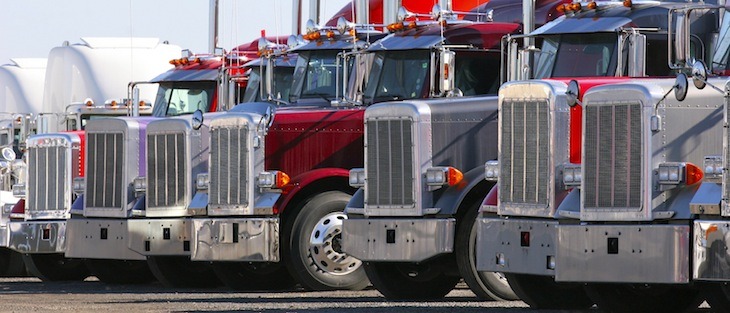SmartDrive focuses on fleet safety using video to improve risky driver behavior
by August 3, 2018 12:45 pm 1,037 views

Trucks with in-cab cameras monitored by SmartDrive Systems start recording when a driver is speeding or hard braking or cornering, and companies with the cameras can select how the SmartDrive team reacts to the video, based on each company’s set importance of an event triggering the camera to start recording.
In a recent Transport Topics webinar, executives of San Diego-based SmartDrive Systems, a video and analytics technology company focused on improving fleet safety, discussed improving truck driver safety. Transport Topics is a publication of trade organization American Trucking Associations.
Julie Stevens, director of customer success for SmartDrive, said an unbelted driver might not be a significant issue for one company but to another, would be firing offense.
“We want you to focus on drivers exhibiting the greatest risk,” said Stevens, adding that when companies go to coach a driver they can focus on what needs to be changed.
Stevens showed a video in the webinar in which a truck driver starts to make a U-turn from the right lane of two left-turn lanes. SmartDrive has the ability to identify when drivers make U-turns, she said.
SmartDrive uses three key performance indicators to determine how it’s improving a fleet’s driver safety: a driver’s safety score, the percentage of coaching events and the effectiveness of the coaching sessions. Within the first year of using SmartDrive, clients see a reduction in collisions by more than 50%, Stevens said. In the following years, clients continue to see a slow reduction in collisions.
Erik Contreras, senior customer success manager for SmartDrive, explained that armored car company Dunbar Armored, which has been in business for more than 100 years and operates nationwide, has used in-cab cameras as a means to protect its employees and holds all drivers to the same standard. The ability to coach its employees is key to the company’s brand and employee safety.
‘NO SILVER BULLET’
“Coaching is really a people issue,” Contreras said. “There’s no silver bullet.” It’s something that managers and senior leadership take time to complete for employees.
Dunbar has 20 safety officers that are involved in its coaching program daily, and each week, SmartDrive calls with the company to gauge how the company is leveraging the program.
In its Houston business, it had an issue with a high driver safety score. The target was a 64, but one driver had a 2006. The driver had been coached 26 times for incomplete stop: 44% of his score was a result of incomplete stops, and 37% was a result of unsafe following. SmartDrive included its senior vice president, vice president, site manager and safety office to understand the issue and to determine how to resolve the issue.
“We want to make sure we were focused on 10 of the most riskiest drivers,” Contreras said.
They developed a plan that was realistic, found out who the drivers were and whether they were being coached. Often, the newest drivers are the most risky because they are still acclimating to the position. If a driver were to be a repeat offender, the driver must be reported to a manager. Drivers that are repeat offenders should be retrained, disciplined or disqualified from an incentive program.
The driver with the 2006 safety score decreased it to a 54 after the company determined it was a manager issue, said Contreras adding that he’s an advocate for SmartDrive as a result of spending time with him. The company has improved several safety issues in the first quarter of 2018, from the fourth quarter of 2017. Incomplete stops fell 26%, speeding was down by 23%, mobile device use dropped 22% and unsafe following declined 13%.
SWIFT COACHING
The best approach to change behaviors is swift coaching, Contreras said. Communication is important to express why coaching is necessary for a specific behavior. Self-coaching comes when a coaching session becomes a conversation, which is important, he said. Offering reward programs promote a coaching culture.
Companies that aren’t talking about coaching aren’t doing anything about it. Prepare for a coaching session by knowing what to talk about before starting, Stevens said. Then, review the video with drivers. This allows drivers to talk through the incident, and it might bring to light they weren’t aware it was a risky behavior. Finally, write down the coaching session, and consider offering a print out of the report to give the driver. Only note facts, not feelings or thoughts.
It’s important to spend time with drivers and show them the video, said Contreras, adding that “customers say video doesn’t lie.” It might come to a point where a company must cut a driver.
Also, SmartDrive offers fleets examples of a progressive discipline policy, Stevens said. When asked how long fleets spend coaching drivers, Contreras said those with more than 100 trucks, often spend between one and two hours per week. But Stevens said SmartDrive can configure a coaching program for fleets even if they only have five minutes a day.
When asked about coaching drivers who don’t care, Stevens considered whether it was out of ignorance, a bad habit or willful. If it’s a driver who can’t cover a shift and feels he needs to speed in order to make it, see if the driver can make the shift by not speeding. If the driver is willfully speeding, consider progressive discipline.
Contreras said an unwillingness to change is a management issue, and if everyone has the same goal in mind, it’s easier to change behaviors in the fleet. A culture change doesn’t happen overnight, Stevens said, but if management can get employees to buy into something, they can start making a difference. She suggested to focus on one issue at a time.
